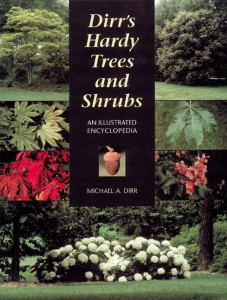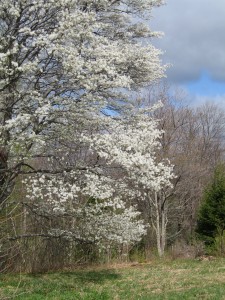Real Dirt Redux/More on Picking Plants
June 15, 2014 by admin
Filed under Garden Design, In the News
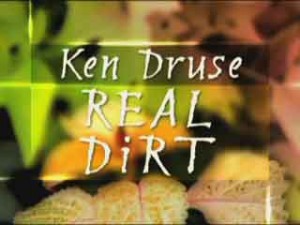 So, when I’m not gardening, I can often be found writing about gardening or talking about gardening. Apparently unaware of just how much I can talk about gardening, “gardening superstar” Ken Druse foolishly invited me to chat with him on his podcast and public radio program Real Dirt. But it’s actually my second time as his guest, which means he had no excuse!
So, when I’m not gardening, I can often be found writing about gardening or talking about gardening. Apparently unaware of just how much I can talk about gardening, “gardening superstar” Ken Druse foolishly invited me to chat with him on his podcast and public radio program Real Dirt. But it’s actually my second time as his guest, which means he had no excuse!
To hear our latest conversation at Ken’s website, click here; for the older podcast, click here and scroll down until you come to the May 7, 2010 episode.
In the new segment, we commiserate a bit about Ken’s frustration with garden media outlets (we will not name names) that are sometimes guilty of talking about plants as if they were furniture. Ken says that equating gardening with decorating the outdoors will just get you into trouble, and I agree. We also talk about favorite shade plants and how gardeners can make better choices by learning to value traits like resistance to disease and deer browsing more highly, instead of focusing solely on flowers. This is basically a matter of separating your wants from your needs with respect to garden plants, and training yourself to give adequate weight to the latter.
I’d been wanting to write a blog post on this subject, anyway, because of a recent experience that I thought illustrated the point pretty well. Not long ago, I had occasion to offer advice to someone seeking a replacement for an ash tree that had met its demise. She specified some challenging conditions the tree would have to tolerate, including clay soil that can get very dry in July and August; a hardiness zone (5B); a desired height at maturity (minimum 30 feet), and if possible, ornamental flowers and/or fruit. If it had ornamental flowers, she wanted it not to conflict with specimens of Rhododendron catawbiense (a late spring bloomer) planted nearby. She also wanted it to be fast growing yet not weak, which in my opinion was the most problematic of her requests because as a general rule those two traits are mutually exclusive (i.e., fast growing usually implies weak-wooded and short-lived), although some trees are worse than others in that regard.
So, given all these needs and wants, what would you do to find a suitable tree if you didn’t have a panel of experts to ask? The approach I recommended reminded me of the old adage about the difference between giving a hungry man a fish and teaching a hungry man how to fish (presumably after giving him a fish anyway so he was no longer hungry, but I digress…).
Rather than give her a list of suggestions, I told her how I would go about generating a viable list. (In my analogy, this would be teaching her how to fish.) First, I referred her to an excellent woody plant book (Dirr’s Hardy Trees and Shrubs by Michael A. Dirr) that I knew to contain lots of lists of trees by characteristic, including height, tolerance of heat and drought, etc. By cross-referencing lists for the most important of the traits she needed, she could come up with a short list, and then whittle it down further by considering lower priority traits.
By starting off with just height, tolerance of dry soil, and cold hardiness, she would have come up with a list of about a dozen trees. About half of those could then have been eliminated on the basis of their weak wood, tendency to become “weed trees,” or other undesirable characteristics. Candidates that remained included our native thornless honey locust (Gleditsia triacanthos var. inermis) and Indian bean tree (Catalpa speciosa or C. bignoniodes), as well as non-native European hornbeam (Carpinus betulus) and hedge maple (Acer campestre).
At that point, she would have had to do some additional research to settle on the one that was best for her. It would also have been advisable to research specific superior cultivars. As a last step, I’d call my local cooperative extension office or agricultural experiment station to discuss my final round draft picks, as well as to make sure none of my choices were on my state’s list of banned or invasive plants. (Click here to visit a website with links to invasive plant information by state.)
Interestingly, one tree that my approach didn’t generate (because it wasn’t on the height list in Dirr’s book that I would have expected) would also have been an excellent choice, in my opinion: tree-form shadblow (Amelanchier arborea or perhaps A. x grandiflora). I gushed about this beauty in my post Alight with White: Native Flowering Trees to Brighten Spring Days. While shadblow is usually thought of as wanting to grow at the woodland edge, I know from observation that wild, native shadblow in my area naturally grow in very punishing conditions on hot, dry, south-facing slopes. Whether nursery stock available at retail could be expected to perform like that is one of the things I’d discuss with the woody plant experts at cooperative extension. But regardless, it’s got a lot going for it: a moderate growth rate (resulting in a reasonably long age and reasonably strong wood), a very attractive form, subtly striated bark, delicate flowers that appear far earlier than those of Rhododendron catawbiense and would not cause a conflict, small fruits that birds eat and hence don’t cause a big mess, good fall color, and much more.
But even without that tree on the list, the process would have generated some good choices and functioned like a signpost pointing the gardener in the right direction. It would have formed the basis for a useful conversation with cooperative extension. Finally, it could have helped circumvent a problem gardeners don’t always anticipate: with some regularity, the woody plant you go to the nursery intending to buy isn’t available, or perhaps you just can’t find a good specimen. You want to have a second choice, and even a third, just in case your first choice can’t be found with ease. I am fond of saying that gardeners should almost always go to nurseries knowing in advance what they want to buy. This process helps you get to a place of confidence about your prospective garden addition, and also helps keep you from getting derailed if your number one choice doesn’t work out.
So, what I just described is basically the problem-solving process I go through every time I’m called on to choose plants. It can be applied to perennials with just a few modifications, taking into account that failure is much more likely with perennials than with woody plants, in part because perennials are much more prone to animal browsing. It really just boils down to recognizing that what you need is just as important as what you want, and trying to strike a satisfactory balance. If you try this method, let me know how it works for you!
Plants Are Not Created Equal
March 12, 2014 by admin
Filed under Garden Design, Perennials, Regional Gardening, Shade Gardening
Over the coming months I’ll be basing a number of blog posts, including this one, on material from my forthcoming book, The Shady Lady’s Guide to Northeast Shade Gardening. The official publication date is May 6, 2014. You can learn more about the book here, here and here.
In my last blog post I talked about a process of elimination I think gardeners should use in order to choose perennial plants for their gardens and why I believe that process will result in the best choices. The rationale behind it can be boiled down to a few simple words: plants are not created equal—at least not from an ornamental gardening standpoint. Some are much better garden performers than others.
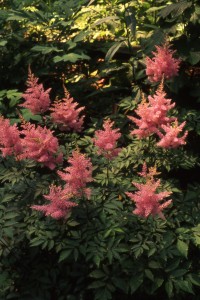
Astilbe is an excellent example of a backbone plant: it looks good all season and doesn't require tons of work.
It’s also important to realize that there’s no such thing as an ideal plant. You should no more expect perfection from a plant than a person, so you may have to give a little when it comes to your preferences.
Looking back at all the questions I said you should ask yourself when considering plants for your garden, I want to be clear that I’m not telling you there’s any plant for which all the answers will be what you want them to be. I’m just saying that for some plants a lot more of those questions have good answers, and those are the ones you should use to fill most of the space in your shade garden.
In fact, I have a name for these superior garden candidates: “backbone” plants. These are ornamentals whose exceptional qualities make them the best choices for filling the majority of the space in your garden. If you use them in abundance, they’ll hold your garden together and keep it solid, like a spine supports a body. Everything else, to one degree or another, is filler.
Strive to use backbone plants for at least 75-80% of your garden. Actually, you could build your garden from nothing but backbone plants, but for the sake of variety, you may allocate 15-20% of the space to secondary, filler plants that I refer to as “accent” plants. Finally, you can devote 5-10% of the space to a few annuals or tender perennials if you really feel the need to have them.
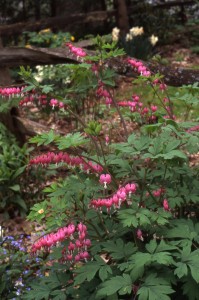
Old-fashioned bleeding heart is certainly a pretty face, but without staying power it doesn't qualify as a backbone plant.
So, what are some examples of backbone plants? I’ll give you two examples of backbone shade plants here, although this process of categorizing plants by their ability (or not) to deliver long-season performance applies equally well to sun as to shade.
The astilbe pictured above is a great example of a backbone shade perennial. It has strong, prominent flowers and attractive foliage, it’s not incredibly picky about growing conditions, it doesn’t require a lot of care, and it isn’t invasive. For those of us in the Northeast, its admirable cold hardiness is an essential quality, and the fact that deer generally ignore it is a godsend. Its only shortcoming is that it
really only flowers well in light shade at northern latitudes; in deep
shade, flowering will be minimal.
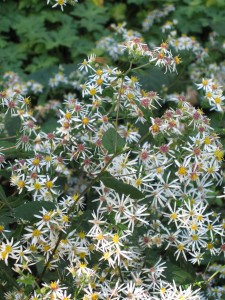
White wood aster is an underappreciated but very fine native backbone plant.
Plants like astilbe and white wood aster are reliable and unfussy—like friends who are easy to be with and always come through in a pinch. But you’ll notice that neither one gets “perfect marks.” As I pointed out earlier, it will almost never be the case that a plant perfectly suits all your needs and desires.
And they are not no-maintenance plants—there is no such thing in a garden setting. Each one has a rather predictable growth habit or behavior that will eventually demand your attention—astilbes often want division every few years, while white wood aster will migrate and have to be kept in bounds—but neither one will require an onerous amount of work. What they offer is a high likelihood of being successful additions to your garden, delivering steady results through the years while not making you regret ever planting them.
I know that this way of thinking about plants and plant selection may seem novel or even backwards to many readers. Gardeners are inundated with the message that gardening is all about personalizing your space and expressing your taste, not to mention the message that it should be cheap and easy, to boot (it generally isn’t, but that’s a topic for another blog post). While it’s certainly true that your garden should reflect your individuality, focusing too much on that obscures some inconvenient facts. Successful gardening means finding a manageable way to get good results given your budget of time and money, and for most homeowners that means putting functionality first.
I hope I’ve persuaded you of the value of using my approach. If you need a little more convincing, consider this: in the early years of my ornamental gardening experimentation, I bought a lot of plants I liked a lot and proceeded to…kill them. Mostly—because I was trying to determine the limits of their shade tolerance—I subjected them to inadequate light, and of course, a lot of them expired.
I feel kind of guilty about it now, but all that “horticide” did have a point: those sacrificial plants eventually taught me to categorize a wide range of shade perennials by both their needs and their performance potential for gardeners. In the process, I came to appreciate a whole new palette of plants for their ability to tough out the difficult conditions we Northeast shade gardeners face.
In my upcoming book, The Shady Lady’s Guide to Northeast Shade Gardening, I elaborate on the topic of what makes a superior shade garden perennial and how to use a wide range of shade plants to good effect. I hope that knowledge will help you find the best choices for your particular situation.
How (Not) to Pick a Plant
February 6, 2014 by admin
Filed under Garden Design, Perennials, Shade Gardening
Over the coming months I’ll be basing a number of blog posts, including this one, on material from my forthcoming book, The Shady Lady’s Guide to Northeast Shade Gardening. The official publication date is May 6, 2014. You can learn more about the book here, here and here.
When you pick perennial plants to put in your shade garden, how do you do it? Most people would start out by picking plants they like—and that’s where they’d make their first, and worst, mistake.
Huh? What? Surely I can’t be advising you to pick out plants you don’t like?! No, of course not. But think about this for a second. When you go shopping for a new car, do you just pick out the one you like the best? No—at least not if you’re like most of us. If that were all it took, we’d all be driving around in Ferraris and Lamborghinis. The problem with that approach is that most sports cars won’t do what most people need a car to do: get up a snowy hill on a winter day and deliver you to your job in one piece, or get enough miles to the gallon to not break the fuel budget.
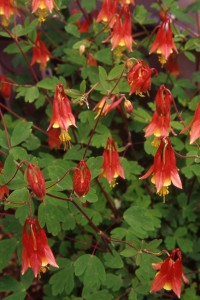
Flowers, flowers, we all like flowers—but there are many other important things to consider when choosing shade perennials.
In other words, we consider practical things. As weird an idea as this will seem to many people, you should do the same thing when you pick out plants—if you want your garden to look good with minimal effort and expense for the longest possible season.
Not all plants are equally good at doing that. In fact, for any given type of garden in any given region, only a small number of plants will give that kind of superior performance, in the same way that, in all likelihood, only a small number of cars will satisfy your criteria for budget and functionality.
So, what are the practical questions you have to ask when picking out plants? First, the more obvious ones:
• Is the plant cold hardy where I live?
• Does the plant prefer the conditions I can offer it?
It’s self-evident why these are questions you should ask first. It makes little sense to populate your perennial garden with plants that won’t be, well, perennial in your area. It also makes little sense to invest in plants that won’t be happy with the growing conditions you provide them. Matching plants to growing conditions is an essential part of the art of garden design. I’m not going to go into detail here about the fine points of that process; what matters is that you realize its importance.
What else do you need to ask yourself in order to pick the best perennials for shade? Here are a few more:
• Is the plant disease resistant?
• Is the plant prone to insect infestation?
• Is the plant unpalatable to deer and other potential browsers?
• Does the plant spread or seed aggressively?
• Does the plant typically go dormant before first frost?
• Does the plant have foliage that looks good all season long?
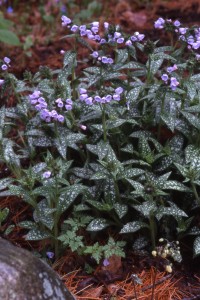
Powdery-mildew resistant Pulmonaria 'Roy Davidson'
The benefits of disease and pest resistance are obvious. Lungworts (Pulmonaria, see photo at left), for example, have unique speckled foliage that can brighten shady nooks and crannies, but most of them are prone to a disfiguring fungal disease called powdery mildew that leaves them coated with an unattractive whitish film. Luckily, some lungworts are resistant. If you buy only the resistant ones, you’ll be able to enjoy the beauty of disease-free lungworts, and you won’t have to expend extra effort to keep them that way.
It’s the same story for all the other questions above. By carefully selecting plants that aren’t palatable to most insect pests and browsing animals, you eliminate the need to take action to stop various critters from nibbling. Likewise, you reduce the need for work (and increase the percentage of your time in the garden devoted to enjoying it) by avoiding overly aggressive spreading plants.
Finally, as a general rule plants that perform well over a long season should be given priority over those that go dormant early or whose foliage declines in quality after flowering. Obviously, we’d all prefer a garden that looks full and good for the longest possible stretch of time.
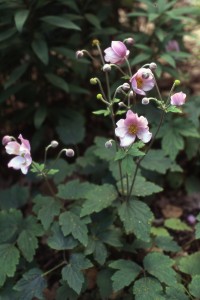
The long-flowering Japanese anemone cultivar 'Robustissima'
• Does the plant have attractive, prominent flowers? (Finally!)
• Do the flowers have a scent that’s nice, objectionable or simply absent?
• Do the flowers last a long time?
And there you have it: questions about flowers are in last place. Now, I want to clarify something. I understand perfectly why so many home gardeners give in to the temptation to fill their properties with plants having beautiful flowers. Beautiful flowers are lovely to look at—it’s as simple as that. The problem is that we don’t live in an ideal world. Flowers fade, and most perennials only produce flowers for two to three weeks every year under the best of circumstances. That’s not very long, so if you pick plants based on how well you like their flowers, you won’t get much bang for your buck.
I’m not saying that you should ignore a plant’s flowers when making choices. For instance, it is true that a small number of perennials will flower for a longer-than-average time, and can be worthwhile making room for these plants in your garden for that simple reason. One example is the Japanese anemone pictured above. I’m just saying that most of the time you should only be considering the flowers of plants that have passed muster in a lot of other ways first. Flowers should be your last consideration, not your first.
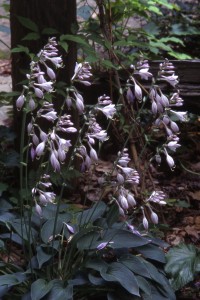
Cut these hosta flowers off? Not me!
In my next blog post, I’ll elaborate a little more on what makes a superior shade perennial and share a few examples.
Lessons from a Tough Year
January 3, 2010 by admin
Filed under Garden Design, Perennials
2009 was the worst growing season in about a decade. Here in the Northeast, it started out as “the year without a summer” and then became “the year with the summer we wish hadn’t come after all.” After a long, ultra cool and rainy spell it became stiflingly hot and humid practically overnight. Only in September did it become tolerable, but it remained erratic.
While I don’t want to see another year like 2009 any time soon, difficult weather years provide good opportunities to learn valuable gardening lessons. Weather, of course, has a big influence on garden beauty (or ugliness) mostly because of its impact on plant health. When plants struggle, gardens don’t look good. 2009 was a year in which lots of plants struggled.
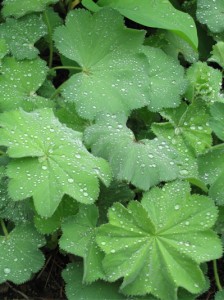
In 2009, lady's mantle withstood weather that devastated many other plants.
Mostly it was a matter of disease. If it was fungal, we had it here in the Northeast: powdery mildew, late blight (along with every other kind of blight), rust, rust and more rust, and rots I couldn’t begin to identify. At one point I heard informally that commercial plant growers were spraying fungicide at unheard-of rates. It wasn’t hard to believe. I, too, sprayed things I’ve never sprayed before in hopes of nipping diseases in the bud, but many normally reliable performers succumbed. The undersides of Hydrangea arborescens leaves became a mass of orange pustules before dropping off prematurely. Snapdragons bloomed half-heartedly and then rotted at the base. Even hostas, normally great performers, were a total loss—not because of disease, but because 2009 was also a record-breaking slug year!
So, what was still looking good at the end of that horrendous season? In the shade department, Hellebore, Epimedium, Siberian bugloss (Brunnera), Geranium macrorrhizum, Rodgersia, white wood aster (Aster divaricata), Heuchera villosa ‘Autumn Bride’, wild ginger (Asarum), ferns and (in light shade) astilbes and lady’s mantle (Alchemilla) were some of the best performers among perennials. That’s what I’d expect. These plants always look good. Any shade garden designed for long-term low maintenance and long-season interest in the Northeast (as long as it’s not a native plant garden) should be made up primarily of plants like these.
Among sun-loving perennials, many North American natives really showed their strength. Bluestar (Amsonia tabernaemontana), turtlehead (Chelone), tickseed (Coreopsis), purple coneflower (Echinacea purpurea), Helenium, Rudbeckia fulgida and Culver’s root (Veronicastrum virginicum) all sailed through summer. Phlox maculata ‘Rosalinde’ proved once again why it’s superior to every other phlox out there.
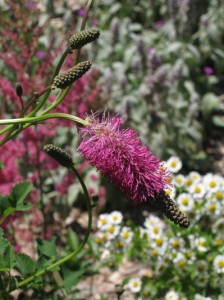
Burnet (Sanguisorba) looks delicate, but it came through 2009 with flying colors.
Among the non-natives, catmints (Nepeta), daylilies (Hemerocallis) and betonies (Stachys) of all kinds seemed no worse for wear, as did some lesser-known perennials such as burnet (Sanguisorba). Grasses showed a lot of resilience, although some didn’t attain their normal size because of the extended cool spring (most ornamental grasses need sun and heat to develop). The story is the same here as for shade plants: the ones that looked good at the end of 2009 were the ones that always look good.
So what’s the lesson here? To fill your garden with plants that are naturally disease resistant. They are the only ones capable of looking good whatever the weather delivers, and 2009 was the proof of that pudding. It’s fine to have some plants you just like a lot, even if you know they’re temperamental, but a garden full of them will eventually disappoint.
This winter, if you’re thinking about making additions to your garden in 2010, my advice is to pay careful attention to the invisible qualities of plants, like disease resistance. They’re the equivalent of a great personality in a human being—they may not be what you notice first, but they’re what you’ll grow to appreciate in the long haul. And with that thought in mind, here’s to some easier gardening years in the coming decade!
A Spring Thing: Flowers in the Shade
May 31, 2009 by admin
Filed under Garden Design, Shade Gardening
Here we are at the start of June. By the time summer arrives in three weeks, the majority of perennials in northern shade gardens will already have finished blooming. Is that surprising? You may never have realized it, but most shade tolerant perennials bloom in spring.
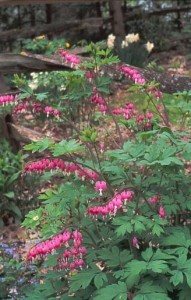
The dangling pink hearts of Dicentra spectabilis are just a memory by the start of summer.
Think about it: hellebore, lungwort, violet, nodding mandarin, epimedium, Solomon’s seal, old-fashioned bleeding heart, most primroses, globeflower, Siberian bugloss, twinleaf, woodland phlox and many other shade standards are already done flowering. False Solomon’s seal, rodgersia, columbine, spotted geranium, bigroot geranium and mayapple are in bloom now, but they’ll be finished by late June, too. Foamflowers are fading (although if deadheaded they’ll put up more flower stalks), and the fruits of baneberry and goldenseal are already fattening up! Yup, flowers in the shade are mainly a spring thing.
What’s left to please the eyes of shade gardeners through the coming months? Goatsbeard, astilbe, hosta, bugbane, Japanese anemone, toad lily and woodland aster are all yet to come. There are more, of course, yet the fact remains that most shade perennials bloom very early in the year. I’d guesstimate 75% of them have wrapped up their flowering by the summer solstice.
There’s a good reason for that, of course. We tend to forget that plants don’t flower to please us. They have their own agenda: reproduction.
In our mostly deciduous temperate forest, the woodland is a full sun environment from November through April when the leaves aren’t on the trees. Most of that time, it’s too cold for perennials to grow, but in March and April, it’s just warm enough for them to shoot up quickly and do energy intensive things like flowering and setting seed while there’s plenty of sunlight to fuel the process. When the trees leaf out in May, many woodland perennials are winding down and looking forward to doing what we all would do if we could get away with it: lounging about all summer.

The best foliage plant ever? Hosta.
The tendency of woodland plants to flower in spring is the main reason why shade gardeners are often advised to stop focusing on flowers and instead rely heavily on exceptional foliage plants: ferns, hostas, sedges, and variegated plants such as (to name just one example) Brunnera macrophylla ‘Variegata’. Flowers will come and go in weeks, but foliage is season long.
Annuals can also help keep color going through the warm months, but the choices for shade in the north are severely limited. Begonias and impatiens are two obvious answers, and they’re readily available at low cost. Gardeners who have grown bored with wax-leaf begonias can try the dragon-wing types for some variety. These grow larger than wax-leaf begonias, are extremely floriferous and make more of an impact, but they also cost more since they aren’t available in 6-packs but have to be purchased in 4-inch pots.
Caladiums are another great choice for summer color in shade gardens, although once again the color is coming from leaves, not flowers. Caladiums are not cold hardy in the North and won’t survive winter in the ground, but they can be dug and stored, dormant, and regrown the following year if you have a bright, warm spot to start them indoors beginning in February or March. Be sure not to put them in the garden too early because they are very sensitive to cool nightime temperatures. Even here in southern New England, I’ve learned not to plant them outdoors until the first week of June. If you do get ahead of yourself with caladiums and they get whacked by an extra-cold night, they should spring back quickly as the weather warms even if their foliage dies back completely in the interim.
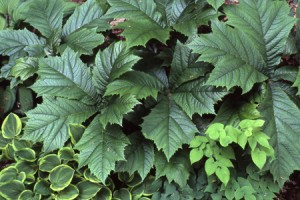
After their flowers have faded, rodgersia and epimedium leaves will continue to bring beauty to the shade garden.
Don’t forget that lots of those spring blooming shade plants I mentioned earlier also have great foliage that will contribute to the beauty of your garden right up until the first frost. Rodgersia, epimedium, hellebore, Solomon’s seal and twinleaf are just a few examples of plants that would be worth growing even if they didn’t flower! So, when designing your shade garden, consider each plant’s total contribution to the effect through the whole growing season, not just the loveliness of its flowers, its most ephemeral aspect.
Captivating Cottage Gardens
March 18, 2009 by admin
Filed under Cottage Gardening, Garden Design
Cottage gardens possess an allure unmatched by any other kind of garden. Maybe it comes from being the horticultural equivalent of a woman with an hourglass figure, or maybe it’s just because they’re packed with such a variety of plant life that they’re never the same two weeks in a row, but whatever the source of their mystique, cottage gardens draw people like bees to nectar.
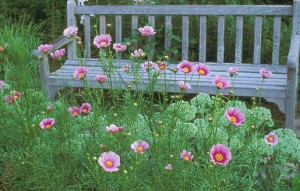
Cosmos takes center stage in a sweet cottage garden scene
This spring I’m giving a series of lectures about cottage gardening, focusing primarily on a very particular cottage garden I designed and built starting in 2000. At nine years of age, it’s had plenty of time to mature and evolve. Many good gardening lessons can be drawn from it, and I’ll be sharing them with you over the coming months.
If you’re in (or plan to be in) southern New England this spring, check out my lecture schedule to see if you can’t fit one into your plans. Most of them are free, and you can’t do better than that!
To get things started, I’ll just say a few words about what a cottage garden is. The origins of the cottage garden go back hundreds of years to a time when most people grew a significant amount of their own food and made a great deal of their own household products—from soaps and dyes to medicines—mostly from plants. Cottage gardens are named for the country cottages around which they were found. Although cottage gardens as a phenomenon certainly weren’t restricted to the British Isles, we did inherit the cottage gardening tradition primarily from the British by virtue of our shared history.
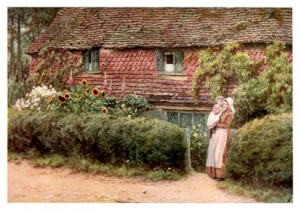
An artist's depiction of a traditional British cottage garden
Several things characterized the traditional cottage garden. It was on the small side, informal and not “designed” in anything like the modern sense of the word; it was a garden belonging to a person of modest means; it was a mix of flowers, vegetables and herbs (although the word “herb” meant something different then—more on that later); the plants in it were procured cheaply, usually in the form of passalong cuttings, divisions and seeds from friends and family; and it was densely packed with plants in order to maximize the productivity of a limited space.
Today’s cottage gardens are often strictly ornamental, vegetables and herbs now having their source at the local grocery store. They can be large, upscale and filled with the most fashionable of exotic vegetation, or they can be spaces where every resident plant carries an association with a loved friend or relative who gave it as a gift. Despite these differences, cottage gardens still look a lot like their ancestors—a testament to the adaptability of a loosely defined garden style. In fact, the only real requirements for a cottage garden are that it have a blowsy, freewheeling look and a lot of different flowering things.
That’s all for now—I hope you’ll join me over the coming months as we look in depth at how to make captivating cottage gardens.


